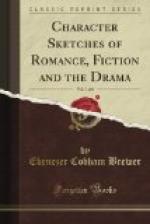Southey, Curse of Kehama, xv. 1 (1809).
BAN, king of Benwick [Brittany], father of sir Launcelot, and brother of Bors king of Gaul. This “shadowy king of a still more shadowy kingdom” came over with his royal brother to the aid of Arthur, when, at the beginning of his reign, the eleven kings leagued against him (pt. i. 8).
Yonder I see the most valiant knight of the world, and the man of most renown, for such two brethren as are king Ban and king Bors are not living.—Sir T. Malory, History of Prince Arthur, i. 14 (1470).
BANASTAR (Humfrey), brought up by Henry duke of Buckingham, and advanced by him to honor and wealth. He professed to love the duke as his dearest friend; but when Richard III. offered L1000 reward to any one who would deliver up the duke, Banastar betrayed him to John Mitton, sheriff of Shropshire, and he was conveyed to Salisbury, where he was beheaded. The ghost of the duke prayed that Banastar’s eldest son, “reft of his wits might end his life in a pigstye;” that his second son might “be drowned in a dyke” containing less than “half a foot of water;” that his only daughter might be a leper; and that Banastar himself might “live in death and die in life.”—Thomas Sackville, A Mirrour for Magistraytes ("The Complaynt,” 1587).
BANBERG (The Bishop of), introduced in Donnerhugel’s narrative.—Sir W. Scott, Anne of Geierstein (time, Edward IV.).
BANBURY CHEESE. Bardolph calls Slender a “Banbury cheese” (Merry Wives of Windsor, act i. sc. 1); and in Jack Drum’s Entertainment we read, “You are like a Banbury cheese, nothing but paring.” The Banbury cheese alluded to was a milk cheese, about an inch in thickness.
BANDY-LEGGED, Armand Gouffe (1775-1845), also called Le panard du dix-neuvieme siecle. He was one of the founders of the “Caveau moderne.”
BANKS, a farmer, the great terror of old mother Sawyer, the witch of Edmonton.—The Witch of Edmonton (by Rowley, Dekker, and Ford, 1658).
BANQUO, a Scotch general of royal extraction, in the time of Edward the Confessor. He was murdered at the instigation of king Macbeth, but his son Fleance escaped, and from this Fleance descended a race of kings who filled the throne of Scotland, ending with James I. of England, in whom were united the two crowns. The witches on the blasted heath hailed Banquo as—
(1) Lesser than Macbeth, and greater.
(2) Not so happy, yet much happier.
(3) Thou shalt get kings, though thou
be none.
Shakespeare, Macbeth, act i. sc. 3 (1606).
(Historically no such person as Banquo ever existed, and therefore Fleance was not the ancestor of the house of Stuart.)
BANSHEE, a tutelary female spirit. Every chief family of Ireland has its banshee, who is supposed to give it warning of approaching death or danger.




